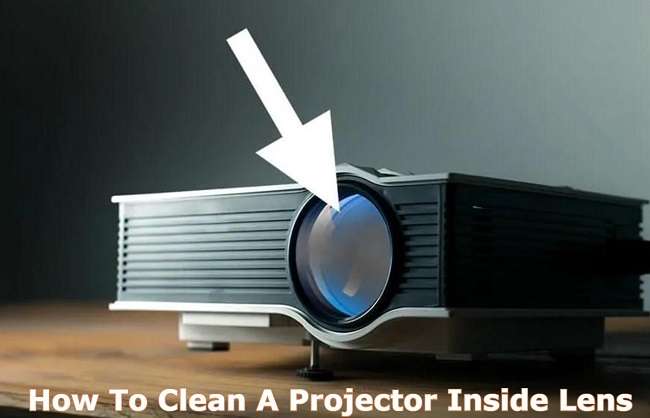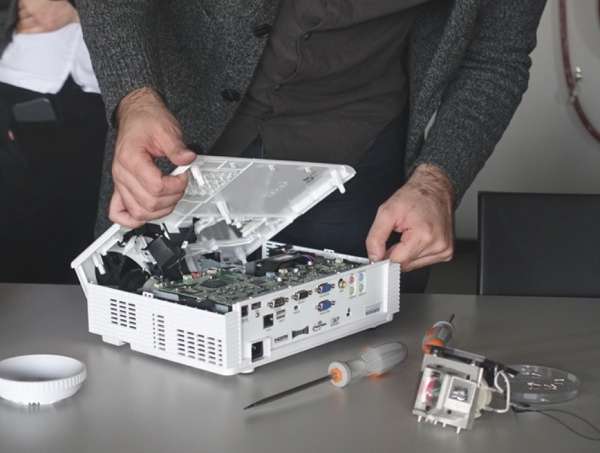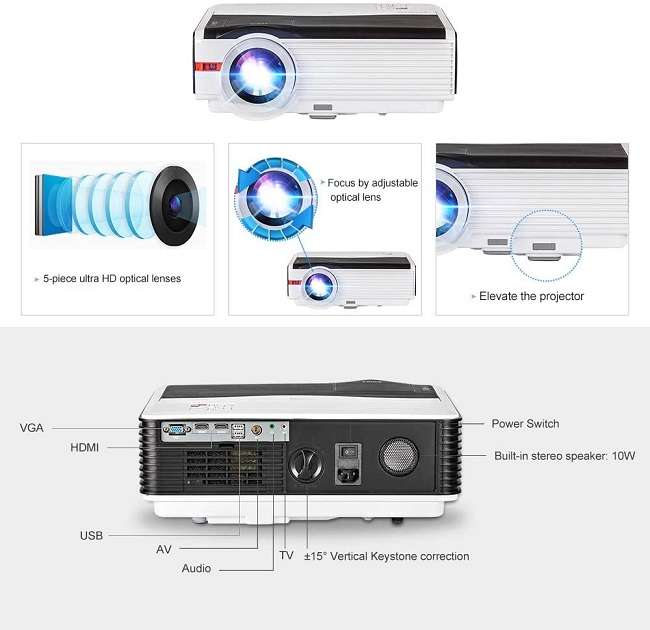Cleaning your projector can be one of the most challenging tasks. When you are cleaning the outside, it is easy to see where dust and dirt collect on the lens. But what about inside? Dust and dirt can build up in there over time causing your image quality to suffer.
It’s important that you have a clean projector so you don’t notice any pixels or poor contrast when watching a movie or TV show. How to clean a projector inside lens? If you don’t know where to start, follow these simple steps. Read this article for tips on how to keep your projector clean!
What You Will Need clean projector lens
Cleaning a projector lens is both quick and easy. While the maintenance task may be challenging, you only need to complete some initial preparation before beginning the process which takes little time.
You will require:
- A microfiber lens cloth is essential for cleaning dust and oils off of your camera’s lenses.
- Compressed air is dangerously flammable.
- Paper wipes
- Lens cleaner/lens wipes
- You may want to consider extra equipment such as a lens cleaning brush.
- Using Tissue papers is not as effective at removing oil from the lens.
- Make sure that you have adequate lighting to be able to see how clean your projector and camera lenses are being cleaned.
- The process is quick, simple and easy to carry out especially if you prepare beforehand.
- You shouldn’t need to spend more than a few minutes on it.
How to clean a projector inside lens – 14 Ways Step By Step
1. Turn off the projector and unplug its power cord from the wall
Before you get started on the job, turn off the projector and unplug it from the wall. Make sure all electrical equipment is switched off before you begin any maintenance. Electrical power can kill if your body absorbs enough heat through current flow. You should never handle a projector or camera lens with wet hands!
2. Turn off the lens shift functions and lock off the focus ring if there is one
Different projectors will require different steps when performing this step. Check your manual to see how to access this setting for your particular model of projector.
Lens shift is what moves the image up and down or left to right depending on which way you are moving it in relation to the front of the projector itself. Most modern projectors will have lens shift or come with it as a feature, if you do not have this option turn off the projector and ensure that there are no obstructions between your projector and screen.
The focus ring is what moves the lens in and out of focus on your camera. Ensure that this is locked into place to avoid any damage to the front element of your projection lenses during cleaning. You can check the best projector under 2000.
3. Open the projector
Ensure that the lens is properly shut before cleaning. Unscrew the screws on the sides of your projector to open it up and expose its insides.
4. Shine a flashlight in from the front
Use a flashlight or other bright light, preferably high-powered. You need to see inside clearly so you clean everything using compressed air around each individual part.
Make sure there’s enough lighting for you to see what you’re doing. Shoddy lighting can cause longer load times, as well as annoying hot spots on the projected image where a particular area isn’t receiving adequate lighting. The brighter your image will be, the less work you’ll have to do later on in post-processing.
There shouldn’t be any significant lens flare around the light source. If there is, you are shining your light from the wrong angle or at an area that doesn’t need to be on. You may explore the best 4k projector under 1000
5. Cleaning the front element of your projector
- Using lens cleaning tissues/cloths/wipes, clean off all dust and debris from your projector’s lenses in tandem with the flashlight.
- Remove any dust particles that are stuck on hard-to-reach areas using a compressed air canister. Make sure you don’t spray inside of it!
- You should only use compressed air cans designed for cameras and video equipment (but make sure not to get it in your camera!), which shouldn’t cause damage even if sprayed directly onto a sensitive component (such as a lens).
- If you don’t have access to those, make sure to hold the can upright (not upside-down) and point it away from the lens when spraying.
- Spray only enough to remove the particles, and not too much that it causes damage or flooding.
6. Use compressed air to blow debris from inside the lens
Using a can of compressed air, How to clean a projector inside lens by blowing harsh particles away. You want to get rid of anything that might scratch or flake off onto your paint when wiping away at it as well as making sure none fall onto items below such as hardwood flooring or furniture.
The last thing you want to do is go from a projector lens directly onto your expensive hardwood floors and have those tiny particles of dust or dirt scratch across the floor tiles or, worse still, into your wooden floors themselves!
Using compressed air to clean out your camera’s lenses will also remove any corrosive material that may be present on them and prevent it from scratching other items in the area.
7. Blow excess debris from the lens
You don’t want to get rid of everything so ensure that you leave enough for lenses on there so when you start wiping they won’t scratch each other. You just need to blow off most of the debris and some dust. You can use a soft cloth instead of compressed air, but make sure the cloth isn’t abrasive as this can cause scratching.
A microfiber lens cloth is a must for cleaning projector lenses. You should never use tissue papers or paper towels to clean your camera lenses as these will tear very easily and will be too soft to remove particulates with any power behind them.
If you have pets inside your house or have children that like to touch everything they find, it is best to avoid using tissues when cleaning your projector’s lens in order to prevent runnier debris from being deposited onto the lens itself during the wiping process.
8. Use a wet wipe to remove excess oil and fingerprints
Before you start rubbing anything on your camera’s lens, clean the lens first with a wet wipe. You want to remove finger grease and any oil residue that you may find on there. Clean your projector lenses regularly and avoid using tissues or paper towels as this just smears what is left behind onto the lens itself. Wet wipes will also prevent dust from scratching the glass when it’s being wiped away.
You may also like:
9. Clean the inside of the projector with compressed air
It’s very important to clean the projector itself. You will need compressed air and a narrow nozzle for your can of compressed air as you want to get inside those crevices where dust tends to gather.
Use the nozzle on your canned air to spray into all areas around the lens (including in between each wheel), especially those that are hard-to-reach, such as around corners and edges.
You should also open up the lens cover so you can blow underneath it too. This is another common place for debris to build up, so make sure everything is thoroughly cleaned before putting everything back together again.
Blow out any dust or debris that may have settled within those cracks and crevices using a narrow nozzle. You can use a lens brush or toothbrush to clean up any of the nooks and crannies that surround your projector’s lens, however, be careful with these and make sure they’re not too rough as you don’t want them scratching anything!
10. Unplug the cable between the HDMI board and lower PCB
Unplug the cable going from your plaque (or motherboard) to the HDMI board so that you can work on it better. This is done by removing the four screws at the end of each side holding it in place.
To disconnect LED light bar, simply lift up on one side until it pops out then continue with another side. Once disconnected do not touch or press down on light bar (it may damage the ribbon cable).
11. Remove screws holding on upper PCB
There are four screws holding on the upper metal shield that covers where you case fan attaches to your projector. These four screws are located in each corner of your projector and there is one screw for each side (the side without your HDMI board attached).
In order to remove these screws, you will need a small Allen key or something similar around 5mm in size. This may be a little awkward as some projectors may not allow you to access this area with tools.
Don’t worry if you can’t get to these screws using a tool; I found it easier just to use my fingers and bend the metal back slightly, although this does run the risk of damaging the projector. You should get a hold of some spare M3x5mm machine screws to replace the ones you remove from your projector, as these are known to get lost easily.
12. Clean the exterior housing
After you remove the four screws holding your upper PCB and metal shield in place, you can take this off. You will need a small flat-head screwdriver to pop off the small plastic cover on the plaque (i.e. where you plug in all of your cables) and then use a cotton bud or Q-Tip to clean around where the fan attaches to the projector as this is commonly clogged with dust.
You will also want to get some compressed air around 50mm long to blow out any excess dust that might have been left behind within your projector case itself when removing these components.
Do not hold down on the switch for more than 10 seconds under any circumstances! Doing so result in damage or inability to switch on the projector.
Make sure you do not hold the switch down for more than a few seconds each time and use this sparingly as your projector may become unable to switch on at some point if you hold the button down too many times.
13. Clean the lens
- You will need a lens cleaning cloth, I find it is easier to use if you wet it slightly first.
- Make sure your projector is powered off before you do this and never touch the lens with your fingers as it can easily scratch or damage it.
14. Reassemble projector
To put everything back together, simply follow the reverse of steps 3-1 taking care to ensure nothing is left behind when putting each element back where you found them. Make sure to reconnect all cables and screw in any components that may have come loose during the process; this includes screws holding down upper PCB, HDMI board, metal shield, etc.
What is the best way to clean dust from a projector lens?
If you have dust or debris on your projector lens, you can use a handheld lens cleaning brush to gently remove this. Typically these brushes are made from camel hair (i.e. the kind used for cameras) which is very soft and will not scratch the projector in any way.
Simply hold down the power button on your projector for 10 seconds while it is powered off to release any residual heat and then blow out any remaining dust using compressed air being careful to avoid touching the lens itself; doing so may cause damage to the unit if excess force causes scratching/damage as noted earlier. You should ideally do this before powering your projector back on, however, I noticed no apparent damage when doing so after having cleaned my projector with my lens-cleaning brush.
Will placing your projector close to a TV have an adverse effect?
In my opinion, it shouldn’t but I would avoid doing this so as not to experience any issues and to ensure there are no compatibility issues between your devices.
Additionally, slotting in the cables described above into their respective ports should stop this from being a problem (i.e. HDMI cable goes from projector to TV).
However, if you really want to place your projector close to a TV without using any of these aforementioned cable slots or by extending them with additional adaptors, you could attach some velcro or adhesive-backed strips (do not use superglue) on the back of both near where the HDMI/Power cable slot into each unit to allow you to affix these components together.
How can you clean a projector lens?
If you have a lens cleaning brush, this is ideal for getting any dust or other particles off the lens.
You can also use compressed air to blow out any dust and debris that may be present on the surface of your projector’s lens but make sure you do this when the projector is powered off and never touch the lens with your fingers as it could easily scratch/damage the unit in question. I would also recommend wetting your lens-cleaning cloth slightly before using it to ensure there is no risk of damaging components during the cleaning process.
What are three common issues with projectors?
The three most common problems with projectors are as follows:
- Dust build-up
- Lamp failure
- Panel failure
How do you troubleshoot a projector?
If your projector is having any problems with the image quality such as flickering or screens that are black and white, this may be due to one of two problems. Firstly, it could be an issue with the lamp so try disconnecting/reconnecting this cable from its slot in the back of your projector (ensuring it is powered off at all times).
If this doesn’t work, then it may be a problem with your panel itself which can either be fixed by replacing components inside or the whole LCD being replaced if needed. A third option would be simply to have your projector repaired but I wouldn’t suggest going down this route unless you know what’s wrong with it for certain (i.e. not just having it done on a whim).
Can you clean the projector lens with alcohol?
Yes, you can clean your projector lens with alcohol but I would recommend first applying some compressed air to it to remove any dust or other particles that may be present before using the acetone-based solution. Also, ensure you are careful when doing so as this solution could damage certain parts of your unit if used excessively, and avoid touching the actual lens during the cleaning process!
How do you maintain and clean projector lens in a car?
If your projector has a removable lens, clean this with a lens cleaning brush/cloth or compressed air and if it doesn’t have one then you may be able to use products such as Brasso which are designed to remove the oxidation on car headlights (however I cannot comment on whether they do work well enough).
You should ensure that any surface dirt is brushed off the lens before you begin applying any of these products and I would recommend using a drying cloth (or compressed air again) afterward to make sure there are no leftover residues/watermarks.
Final Verdict
Cleaning a projector lens is typically done by removing the front cover of the unit. If you have removed your lens and are unsure how to clean a projector inside lens, this article will provide some tips on what to do next. Remember that if you’re not sure about any steps in the process or don’t feel confident enough with doing them yourself, contact an expert for help!


